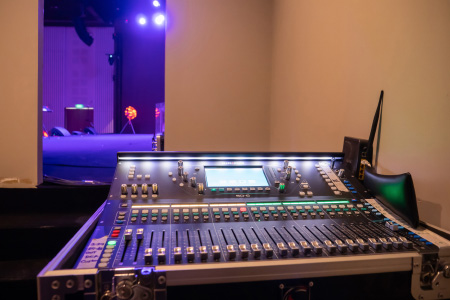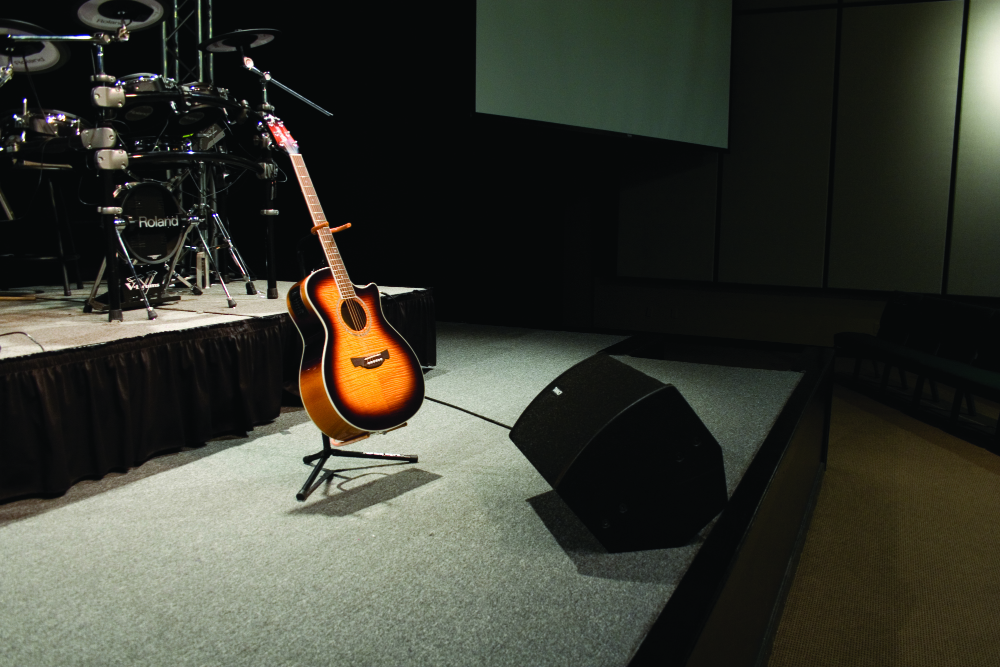It can be tough performing live on a stage – all the noise, Noise, NOISE. This is the first thing in my mind when doing stage monitoring because too much noise can compromise performances and presentations.
It’s hard to be at your best when you can’t hear, let alone think, due to a sonic assault, and no amount of magic monitor mixing or technique is going to fix it.
The noise comes from everywhere. The backside of the house mains. The subwoofers. Various (and numerous) delayed signal reflecting back from the house. Stage sources. The audience. There’s only so much we can do, but minimizing stray energy on stage is a top priority, and then comes the work of devising a monitoring approach that’s best for the performers and production.
When setting up the house system, placement and people are the keys. Placement is where the main loudspeakers are stacked or flown, and people refers to the performers and the audience – we need to serve both.
If possible, the loudspeakers shouldn’t be too close to the stage, helping keep their excess energy off the stage while still insuring they fully cover the audience. Flying/stacking them even a few feet forward can make a significant difference. (Also try to keep their output off of reflective surfaces in the room.)
Loudspeakers on delay further out in the house, as well as front fills, are a good way to get even coverage throughout the listening area without having to crank up the mains too high. Digitally steerable arrays, which my company deploys regularly for both music performances and corporate events, provide an extra degree of welcome control. Cardioid and end fire configurations for the subs can help direct their energy outward rather than backward.
Various Approaches
Now it’s time to turn our attention to the stage monitoring needs of the performers. Wedges, in-ear monitors (IEMs), stage fills, or a combination?
It’s a direction determined by the specific gig, performer preferences, and what we (and perhaps the venue) have available in terms of gear. Everything but in-ear monitoring increases the noise quotient, but that’s usually (and simply) the reality; plus, some musicians like amped-up monitoring.
Over the past several years, a wide range of active 2-way boxes have hit the market with cabinets offering a monitoring angle. They’re quite useful in being able to perform wedge, stage fill and small system main duties. Onboard DSP means they can be optimized for the specific application.

We’re also seeing more active options with traditional wedges. Active does require both a signal and power cable, but there are now options offering both within the same jacket, which can help reduce clutter.
Otherwise, the choice is passive wedges and loudspeakers. They can also be bi-amped (2-way, lows and highs) or tri-amped (3-way, lows, mids, highs), requiring separate amp channels for each section, and may also require an external crossover or processor. Active or passive, options include:
—Mini/personal monitors. Designed to be used very close to a performer, they can be located on the floor, placed on an instrument like a keyboard, or mounted on a microphone stand. The object is to enhance certain parts of the mix (i.e., the vocal), not usually provide the entire mix.
—Standard wedges. Purpose designed and positioned on the floor in mono or sometimes stereo configuration. The most popular types are 2-way designs with a 10-, 12-, or 15-inch woofer and a 1-, 1.5- and 2-inch compression driver mounted on a horn. This category also includes the previously mentioned active loudspeakers. And, a popular variation are coaxial designs that align the LF and HF drivers while occupying a smaller footprint.
—Larger wedges. Usually 3-way systems with a bit more thump and oomph, with the trade-off of being larger and heavier.
—Drum boxes. A specialty loudspeaker to reproduce low frequencies to help drummers better hear the kick (and sometimes bass guitar).
—Drum fills. A single larger loudspeaker, or a group of loudspeakers, to better serve the drummer. Often accompanied by a sub for extra thump.
—Side fills. Also called stage fill, loudspeakers at the sides of the stage, often joined by subwoofers, to augment the output of the wedges and/or IEMs. Some bands prefer side fill exclusively.
—Stage subs. Smaller subs used underneath or alongside a wedge to help augment LF, and these can also be deployed as part of the drum fill or side fill.
These options can be used alone or in any combination, and with IEMs. Just remember, the more loudspeakers on stage, the louder it’s going to be, and there’s increased chance of feedback, both in general and if stationary mics aren’t carefully placed. Plus more boxes can clutter the stage.
Making It Personal
Some musicians love IEMs, others won’t use them, still others are in between, wearing them in tandem with monitoring via loudspeakers. Obviously IEMs cut stage noise and can protect hearing (if they’re not abused) through isolation. A lot of drummers prefer to wear headphones for further isolation.
Earbud options range from generics with replaceable tips of either foam or plastic to custom units molded for the user’s ears. The key is getting a good fit to provide adequate isolation as well as enough comfort so they can be worn for the duration of a show.
IEM/personal monitoring systems are usually wireless, with the performers wearing a small belt pack receiver with volume control. Wired systems are a less expensive option for relatively stationary musicians.
Systems are available in mono or stereo, the latter being the more popular choice. One way to deal with performers feeling too isolated is to add some ambience from the audience into their mixes, captured via an audience microphone or two placed on stage and pointed at the crowd, or flown/placed on stands in the audience area (or front of house).
Several personal mixing systems provide individual mini mixers to performers so they can tailor their own mixes. And a cool recent development is that many digital consoles/mixers now work with custom apps that allow performers to tailor their mixes via tablet or smartphone. Make sure these onstage devices can only access the one mix, and not affect other monitor mixes (or the house mix) by accident.

I mentioned that IEMs offer hearing protection via isolation, but keep in mind that they shouldn’t be turned up too loud. (Kind of defeats the whole purpose.) Also note that a squeal of feedback or loud thud from a dropped mic can be damaging to hearing, so compression and limiting, even brick wall limiting, may be needed to control any unexpected spikes.
Shared Labor
Some shows may just use a few aux sends from the house console to feed the monitors. This can work well for smaller gigs with simple monitoring requirements, but on larger shows, a monitor console is necessary. It should be manned by a dedicated operator, and is usually placed stage side in sight of the performers.
Inputs are shared between the consoles via a split snake in an analog transport system or just grabbed off the network in a digital transport system. The better analog splitters use transformers between the consoles to eliminate hum or buzz, but hard-wired splits can work OK if the system has no grounding and noise issues.
Monitor engineers can make use of a cue wedge at the console to hear each mix if there are wedges used onstage, or they may use IEM to cue up each mix and hear what the performers hear. Many digital consoles allow remote control via tablet, a boon for engineers because they can stand onstage next to performers during sound check and fine tune their mixes.
Lessons Learned
I’ll conclude with some tips that I’ve picked up over the years in working with monitoring over the years.
Acoustic Aiming Devices. I always carry some AADs (black painted pieces of wood) to tilt wedges to put the performers into the coverage pattern. If they can’t hear it clearly, they’ll want more volume.
Shakers. Some performers (drummers in particular) want to really feel the low end, and a seat shaker (a.k.a., butt kicker) can provide this while eliminating the need to add subs. They can also be used with smaller wedges to keep down stage volume.
Directional Subs. With monitor engineers usually at the side of the stage, the wash from the side fill subs can be problematic. A cardioid approach with these subs can help, and some manufacturers offer single cardioid units.
Parametric. Not every problematic tone falls right on the center frequencies, so parametric equalizers deliver added (and needed) precision.
Backup Wedge. Even if all performers are on IEMs, having an extra wedge comes in handy for use with announcers, guest artists and audience members brought onstage, as well as for talkback communication and in case an IEM system goes south.
Identification. Label all wedges with their respective mix numbers. It’s way easier and clearer for a performer to ask for more cowbell in mix 9 than ask for more “in that box.” Also label all IEM belt packs with mix numbers and performers names so they don’t accidentally grab the wrong pack.
Better Reception. Deploying quality antennas with IEM systems can help eliminate dropouts and other RF problems. Directional “paddle-style” (a.k.a., log-periodic dipole array) antennas can provide up to 6 dB of gain and Helical antennas can provide up to 10 dB.
In The Pan. Stereo IEM mixes have more depth and are easier to listen compared to mono. I place performers center in their own mixes and pan the other instruments to the left and right (depending on where those instruments are onstage). And we tailor it together from there…















